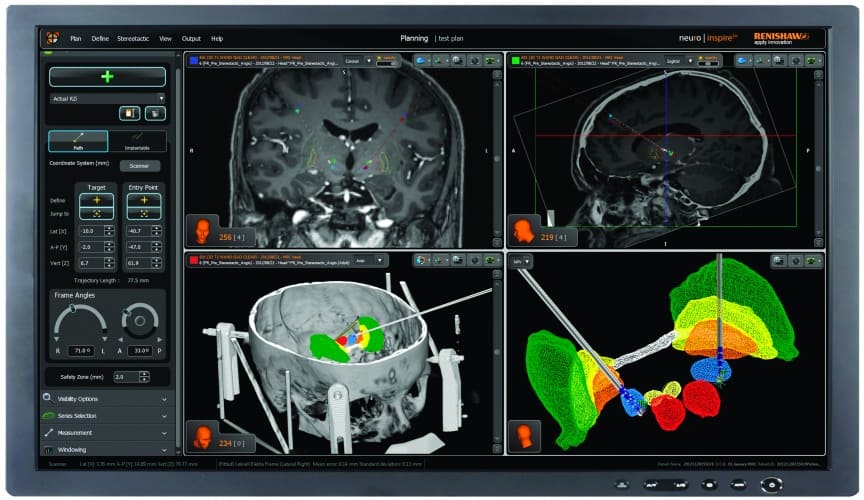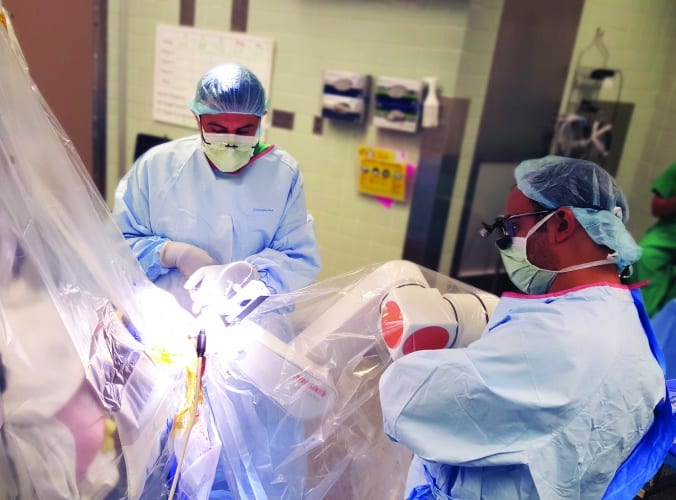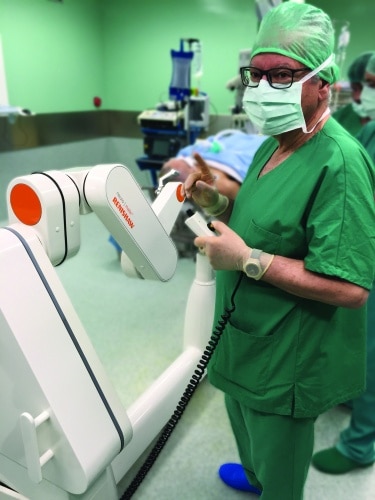The precise field of industrial metrology is a vital part of the world of high-value manufacturing, helping to ensure components are the correct size and shape for their purpose and that production processes remain repeatable and within their tolerances. But one manufacturer is sending its machines into an area where precision and steadiness are even more vital: the delicate sphere of
brain surgery.
Renishaw’s medical business is a growing and exacting part of the Gloucestershire-based metrology specialist’s business. Its best-known activity is its production of custom-designed 3D-printed surgical implants at its facility in Cardiff; it also produces the software tools that help surgeons to design them. But its Neuromate robot takes the precision it is trusted to provide in factories around the
world into the operating theatre.
Brain surgery, of course, requires extreme precision. Just the task of locating the sites in the brain that require the attention of a surgeon is an art in itself. These sites encompass quite a variety of neurological phenomena: they might be tumours that require the precise positioning of an implant to deliver chemotherapy drugs, for example; they might also be sites implicated in conditions such as epilepsy, Parkinson’s disease or severe depression (the latter two conditions can sometimes be treated using a technique called deep-brain stimulation, where an implanted electrode delivers an electric charge to a precise point in the brain).
Once the implicated site has been located, it’s down to the surgeon to devise a route through the brain to position the necessary implant. This will tend to be in a straight line from a hole drilled in the skull, but has to avoid damaging any vital structure on the way. This is a matter of finding a suitable angle to go into the brain, minimising potential damage.

Surgeons do this by locating the operation site using 3D scans of the brain and mapping these onto the patient’s head, then using fixed supports to guide their instruments; first, the drill used to access the brain, and then the implant itself. Conventionally, this is done by hand, by fixing the patient’s head onto the operating table using a device called a stereotactic frame; and then using arc-shaped measuring scales, also fixed to the table, to position supports for the operating instruments. But this is exacting work, subject to the always slightly uncertain vagaries of human skill at the time of the surgery. It also increases the amount of time the patient needs to be under anaesthetic, which carries risk. Moreover, the frame itself can cause trauma; in some cases it is attached using surgically affixed pins.
Neuromate avoids these problems. It is a robotic arm tipped with a mount for surgical instruments. The arm has six swivelling joints to position the mount in precisely the correct position for the surgery planned. It can be used with or without a stereotactic frame, and is equipped with software to help devise and programme in the surgical plan to get implants into the right place.
Although precision movement is a cornerstone technology for Renishaw; for example, in its coordinate measuring machines and Equator gauging devices, Neuromate is not adapted from an industrial metrology device but was designed specifically for surgery.

One procedure for which Neuromate is proving particularly useful is stereoelectroencephalography (SEEG). This is a method for providing an accurate identification of the locations in the brain where electrical disturbances cause epilepsy, for patients suffering from severe forms of the condition for which a surgical treatment might be considered. SEEG involves gaining a rough location of the epileptogenic site using techniques such as dye-tracing angiography to map blood vessels, MRI techniques to image rain structures and external electrodes on the surface of the head to locate abnormal electrical activity, and then implanting electrodes within the brain tissue itself to narrow down the precise location.
Unsurprisingly, it’s a highly exacting process. Up to 20 electrodes are typically used, each one a semi-rigid rod bearing up to 18 electrical contacts along its length, and every single one has to be oriented precisely and inserted through the cortical area of the brain; the outer surface layer, which is dense with blood vessels that the surgeon must not disturb. Neuromate allows placement of electrodes with an accuracy of 0.78mm, according to a study derived from 81 placement operations. In the operation, Neuromate first guides the surgeon’s drill to the precise position for an electrode and then guides the placement of a hollow screw into the drill hole, through which the electrode is inserted. Once the screw has been placed, the robot shifts its arm to the next position, with the whole sequence taking only seconds.

SEEG monitoring generally takes five to 15 days; basically it involves waiting for the patient to have an epileptic episode and monitoring the electrical activity with the implanted equipment.
“Thanks to the use of the Neuromate system, every target can be reached with a combination of speed and submillimetric accuracy,” said Francesco Cardinale, a neurosurgeon at the Ospedale Niguarda Ca’Granda in Milan. “The precision of robotic guided SEEG has revolutionised surgery to cure epilepsy, allowing us to offer cures to a whole new cohort of patients,” added David Sandeman, consultant neurosurgeon at Southmead Hospital in Bristol. Dr Cardinale has been able to perform an operation on the epileptogenic site – a thermal procedure to destroy the troublesome cells – with the electrodes in position.
At the Sainte-Anne Hospital in Paris, consultant neurosurgeon Prof Bertrand Deveaux uses a Neuromate machine for SEEG, biopsies and deep brain stimulation to treat Parkinson’s. “We would not consider doing these manually without Neuromate,” he said. “In my opinion, it is the easiest,
fastest and most precise way to perform stereotactic procedures.”
One particular advantage he find is that it reduces the number of X-rays that need to be taken during surgery to check the position of electrodes, which both reduces the risk to the patient and makes the procedure faster, cutting the time under general anaesthetic.




April 1886: the Brunkebergs tunnel
First ever example of a ground source heat pump?